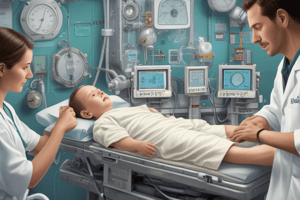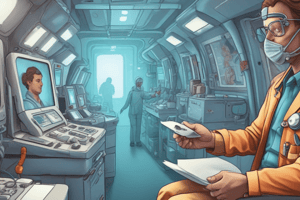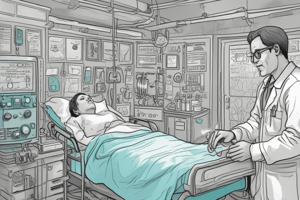Podcast
Questions and Answers
Which of the following tasks is an RCP most likely to perform in the Emergency Department (ED)?
Which of the following tasks is an RCP most likely to perform in the Emergency Department (ED)?
- Inserting simple airway adjuncts such as oral and nasal pharyngeal airways (correct)
- Elective intubation of patients with impending respiratory failure
- Endotracheal tube (ETT) cuff pressure monitoring
- Tracheotomy inner cannula replacement
In the Intensive Care Unit (ICU), RCPs are responsible for which of the following?
In the Intensive Care Unit (ICU), RCPs are responsible for which of the following?
- Airway clearance (suctioning)
- Inserting simple airway adjuncts
- Elective intubation of patients with impending respiratory failure (correct)
- Supporting patients with BVM ventilation during respiratory arrest
RCPs are commonly involved in which of the following activities at the bedside?
RCPs are commonly involved in which of the following activities at the bedside?
- Assisting physicians during bronchoscopy
- Performing emergency endotracheal intubation
- Extubation of patients ready for ventilator discontinuation
- Rapid response to airway emergencies (correct)
What significant aspect differentiates the roles of EMS practitioners and anesthesiologists in airway management?
What significant aspect differentiates the roles of EMS practitioners and anesthesiologists in airway management?
Which of the following tasks is typically part of an RCP’s responsibility in the ICU, but not generally in the ED?
Which of the following tasks is typically part of an RCP’s responsibility in the ICU, but not generally in the ED?
Which role does not typically apply to an RCP in the ED?
Which role does not typically apply to an RCP in the ED?
Why does much of the literature about airway management not apply to RCP practice?
Why does much of the literature about airway management not apply to RCP practice?
Which procedure is included in an RCP’s role in all clinical settings?
Which procedure is included in an RCP’s role in all clinical settings?
What is a specific responsibility of RCPs during a cardiac arrest in the ED?
What is a specific responsibility of RCPs during a cardiac arrest in the ED?
In the ICU, which team member typically monitors the ETT cuff pressure?
In the ICU, which team member typically monitors the ETT cuff pressure?
What is the primary reason endotracheal tube suctioning (ETS) is necessary for patients with endotracheal airways?
What is the primary reason endotracheal tube suctioning (ETS) is necessary for patients with endotracheal airways?
What is the length of most suction catheters used for bedside airway suctioning?
What is the length of most suction catheters used for bedside airway suctioning?
What type of precaution is specifically mentioned as necessary during open suctioning procedures?
What type of precaution is specifically mentioned as necessary during open suctioning procedures?
What procedure is necessary to clear secretions or foreign bodies located distal to the mainstem bronchi?
What procedure is necessary to clear secretions or foreign bodies located distal to the mainstem bronchi?
What is a critical component of every airway care procedure?
What is a critical component of every airway care procedure?
According to the AARC Clinical Practice Guidelines, on what are most existing recommendations for ETS based?
According to the AARC Clinical Practice Guidelines, on what are most existing recommendations for ETS based?
What should be assessed as the first step in the ETS process?
What should be assessed as the first step in the ETS process?
What risk does ETS pose aside from those to the patient?
What risk does ETS pose aside from those to the patient?
How should secretions be removed to minimize risks during ETS?
How should secretions be removed to minimize risks during ETS?
What elements are universally included in the endotracheal tube suctioning (ETS) process according to a recent Medscape Review?
What elements are universally included in the endotracheal tube suctioning (ETS) process according to a recent Medscape Review?
Which of the following is NOT a potential hazard category of airway suctioning according to AARC CPG?
Which of the following is NOT a potential hazard category of airway suctioning according to AARC CPG?
What is a common cause of cardiopulmonary complications during airway suctioning?
What is a common cause of cardiopulmonary complications during airway suctioning?
What is the primary factor causing atelectasis during suctioning?
What is the primary factor causing atelectasis during suctioning?
Which maneuver is recommended to re-inflate atelectatic areas caused by suctioning?
Which maneuver is recommended to re-inflate atelectatic areas caused by suctioning?
What type of complication is biofilm dislodgement considered as?
What type of complication is biofilm dislodgement considered as?
What precaution is essential to take during open endotracheal suctioning (ETS)?
What precaution is essential to take during open endotracheal suctioning (ETS)?
What is the effect of suctioning on dynamic lung compliance?
What is the effect of suctioning on dynamic lung compliance?
Which of the following is a cardiovascular complication that can occur due to hypoxemia during suctioning?
Which of the following is a cardiovascular complication that can occur due to hypoxemia during suctioning?
What is a potential consequence of airway instrumentation by suction catheter?
What is a potential consequence of airway instrumentation by suction catheter?
What infection control practice is critical during airway suctioning?
What infection control practice is critical during airway suctioning?
What is a significant indicator that endotracheal suctioning (ETS) is necessary?
What is a significant indicator that endotracheal suctioning (ETS) is necessary?
What differentiates closed suction systems (CSS) from open suction systems (OSS)?
What differentiates closed suction systems (CSS) from open suction systems (OSS)?
According to the AARC Clinical Practice Guidelines (CPG), what is the recommended duration for administering 100% $O_2$ to adult patients before suctioning?
According to the AARC Clinical Practice Guidelines (CPG), what is the recommended duration for administering 100% $O_2$ to adult patients before suctioning?
Why is routine saline instillation before ETS no longer recommended?
Why is routine saline instillation before ETS no longer recommended?
What is the recommended range of vacuum pressure for endotracheal suctioning in infants according to AARC CPG?
What is the recommended range of vacuum pressure for endotracheal suctioning in infants according to AARC CPG?
What practice is recommended for reducing hypoxia during the endotracheal suctioning process?
What practice is recommended for reducing hypoxia during the endotracheal suctioning process?
What type of suctioning is preferred to minimize mucosal trauma?
What type of suctioning is preferred to minimize mucosal trauma?
Which feature in ventilator graphics can indicate the need for endotracheal suctioning?
Which feature in ventilator graphics can indicate the need for endotracheal suctioning?
What is a guideline for post-suctioning oxygen administration as per the AARC CPG?
What is a guideline for post-suctioning oxygen administration as per the AARC CPG?
When selecting a suction catheter, what critical factor must be considered?
When selecting a suction catheter, what critical factor must be considered?
Which component must be capped when using a regular T-piece in the setup?
Which component must be capped when using a regular T-piece in the setup?
What is the appropriate first step in setting up the In-Line (Closed) Suction Catheter?
What is the appropriate first step in setting up the In-Line (Closed) Suction Catheter?
Where should the ventilator tubing circuit be connected in the T-piece setup?
Where should the ventilator tubing circuit be connected in the T-piece setup?
What must be ensured regarding the irrigation port during the setup?
What must be ensured regarding the irrigation port during the setup?
During the setup, what should be done after washing hands and applying gloves?
During the setup, what should be done after washing hands and applying gloves?
Which specific control valve should be pressed to set the wall suction to the appropriate level?
Which specific control valve should be pressed to set the wall suction to the appropriate level?
What type of T-piece is mentioned as having a specific system in place for tracheostomy?
What type of T-piece is mentioned as having a specific system in place for tracheostomy?
When should the patient end connector be attached to the elbow's side port?
When should the patient end connector be attached to the elbow's side port?
What should be done to the catheter sheath while advancing the catheter?
What should be done to the catheter sheath while advancing the catheter?
Which color indication signifies that the catheter length is correct and should stop advancing?
Which color indication signifies that the catheter length is correct and should stop advancing?
What is the first step in the airway clearance procedure using a closed catheter?
What is the first step in the airway clearance procedure using a closed catheter?
How should suction be applied during the catheter withdrawal?
How should suction be applied during the catheter withdrawal?
What volume of 0.9% NaCl should be instilled to clean the catheter?
What volume of 0.9% NaCl should be instilled to clean the catheter?
What consequence might arise if secretions are left in the catheter or suction line after suctioning?
What consequence might arise if secretions are left in the catheter or suction line after suctioning?
What is the purpose of seeing a length number or length color code during catheter advancement?
What is the purpose of seeing a length number or length color code during catheter advancement?
What should be visible within the sheath to confirm the catheter is fully withdrawn?
What should be visible within the sheath to confirm the catheter is fully withdrawn?
When should 0.9% NaCl be instilled into the catheter?
When should 0.9% NaCl be instilled into the catheter?
Which type of airway adjunct specifically prevents soft tissue airway obstruction (STAO)?
Which type of airway adjunct specifically prevents soft tissue airway obstruction (STAO)?
What is the primary purpose of the head tilt chin lift maneuver?
What is the primary purpose of the head tilt chin lift maneuver?
Which of the following emergency ventilation methods is NOT typically an RCP skill?
Which of the following emergency ventilation methods is NOT typically an RCP skill?
Which tool is used to clear obstructions during laryngoscopy?
Which tool is used to clear obstructions during laryngoscopy?
In the context of airway management, what does the 'A' in the CAB's of life support stand for?
In the context of airway management, what does the 'A' in the CAB's of life support stand for?
Which of these airway opening maneuvers does NOT involve tilting the head?
Which of these airway opening maneuvers does NOT involve tilting the head?
What skill is emphasized as essential for an RCP during CPR?
What skill is emphasized as essential for an RCP during CPR?
Flashcards are hidden until you start studying
Study Notes
Airway Management: Introduction
- Airway management books and articles are primarily written for two main audiences: EMS practitioners and anesthesiologists.
RCPs' Role in Airway Management
- RCPs perform airway management in the Emergency Department (ED), Intensive Care Unit (ICU), and at the bedside.
- RCPs are responsible for airway clearance, airway establishment, and airway maintenance.
ED Responsibilities
- RCPs support patients with BVM ventilation during cardiac and respiratory arrest prior to endotracheal intubation and after extubation.
- RCPs insert simple airway adjuncts such as oral and nasal pharyngeal airways.
- RCPs perform emergency endotracheal intubation.
- RCPs assist the physician during endotracheal intubation, tracheotomy, and bronchoscopy.
ICU Responsibilities
- RCPs monitor endotracheal tube (ETT) cuff pressure.
- RCPs extubate patients ready for ventilator discontinuation.
- RCPs perform emergency re-intubation of accidentally or self-extubated patients.
- RCPs replace tracheotomy inner cannula.
- RCPs perform elective intubation of patients with impending respiratory failure.
Bedside Responsibilities
- RCPs perform airway clearance (suctioning).
- RCPs respond rapidly to airway emergencies.
- RCPs troubleshoot problems with artificial airways and ventilators.
Airway Clearance: Overview
- All airway care procedures require strict adherence to aseptic technique and standard precautions at all times.
Airway Suctioning
- Airway suctioning is performed by applying subambient pressure to the airway through a suction catheter.
- Endotracheal tube suctioning (ETS) is required for patients with endotracheal airways because the artificial airway impedes the normal cough mechanism.
- Most suction catheters available for bedside use are 22 inches long, only reaching the mainstem bronchi.
Importance of Suctioning
- Suctioning is necessary to maintain airway patency, but it is not a benign procedure.
- Clinicians must be aware of both the positive and negative effects of the procedure and the methods used to prevent or minimize complications.
- Open suctioning is an aerosol-producing procedure, requiring droplet precautions.
Clinical Practice Guidelines
- The AARC Clinical Practice Guidelines and other authoritative sources recognize the lack of strong clinical evidence for most ETS recommendations and clinical practices.
- Despite limited evidence, existing recommendations are based on expert opinion and represent available best practices.
- Until more evidence is accumulated, they remain the current standard of care.
Key Elements of ETS
- ETS includes the five common elements: assessment of need, patient preparation, procedure performance, patient monitoring, and follow-up patient care.
- ETS is an invasive procedure that exposes the patient to potential risks, requiring standard precautions and aseptic technique.
- In addition to patient risks, ETS also poses infection risks to clinicians and other patients.
Purpose of ETS
- The primary purpose of ETS is to remove secretions.
- Secretions vary in viscosity and volume, requiring appropriate catheter size and pressure selection.
- Every time the catheter is passed into the airway, the patient and clinician are exposed to all risk factors associated with the procedure.
- Secretions should be removed efficiently using the fewest number of catheter passes.
Airway Clearance: Suctioning Hazards
- Despite the hazards, failure to maintain a patent airway will result in the patient's death, so there are no absolute contraindications to Endotracheal Suctioning (ETS).
Respiratory Hazards
- Removal of air volume in the lung during suctioning can cause:
- Decrease in dynamic lung compliance
- Reduction in functional residual capacity
- Atelectasis (also known as lung de-recruitment)
- Hypoxemia and hypoxia
Cardiovascular Hazards
- Hypoxemia and sympathetic and parasympathetic stimulation can cause:
- Cardiac dysthymias
- Increased intracranial pressure
Neurologic Hazards
- Airway instrumentation can cause:
- Diffuse bronchospasm
Infection Control Hazards
- Environmental contamination of the open suction catheter can cause:
- Microbial colonization of the patient's lower airway
- Biofilm dislodgement by the suction catheter
- Open ETS is an aerosol-producing procedure that requires droplet precautions.
- Strict adherence to infection control and aseptic technique throughout the procedure is essential.
Indications for Endotracheal Suctioning (ETS)
- ETS should only be performed when secretions are present
- Indications for ETS include:
- Audible or visible secretions in the ET tube
- Coarse gurgling sounds (rhonchi) on auscultation
- Coughing movements
- Increased work of breathing (WOB)
- Changes in ventilator graphics (saw tooth pattern on the expiratory half of the flow volume loop)
Suction Systems
- There are two categories of suction systems:
- Open suction systems (OSS)
- Closed suction systems (CSS)
Open Suction Systems (OSS)
- Use a sterile catheter
- Require strict adherence to aseptic technique
- Require the patient to be disconnected from the ventilator
Closed Suction Systems (CSS)
- Use a sterile catheter enclosed in a flexible plastic sleeve
- Only require standard precautions
- Do not require the patient to be disconnected from the ventilator
Preoxygenation
- Preoxygenation is intended to reduce the chance of hypoxia caused by suctioning
- The optimal level and duration of preoxygenation are not known
- The AARC CPG recommends:
- Administering 100% O2 for adult and pediatric patients
- Increasing the FiO2 by 10% for neonates for a period of 30 to 60 seconds before suctioning
Catheter Selection
- The catheter diameter selected must not occlude the ET tube
- The catheter must be able to efficiently aspirate secretions
- Catheter sizing rules of thumb and formulas only refer to airway occlusion size, not to the ability of the catheter to aspirate thick secretions
Vacuum Pressure Guidelines
- Vacuum pressure guidelines vary
- The AARC CPG recommends:
- -120 to -150 mmHg for adults
- -100 to -120 mmHg for children
- -80 to -100 mmHg for infants
Suctioning Techniques
- Measured suctioning (shallow suctioning) is the preferred technique to reduce mucosal trauma
- Most authors recommend that the duration of suctioning be limited to 10 to 15 seconds
Initial Set-up for In-Line Suction Catheter
- Select appropriate In-Line Suction Catheter Fr size for patient's ETT size
- Wash hands and apply clean gloves
- Attach suction catheter connector to vacuum source (wall suction) tubing
- Set wall suction to appropriate level by pressing suction (thumb) control valve
- Attach Patient end connector to side port on elbow (modified T-piece)
- Use T-piece for tracheostomy systems
- Securely cap arm opposite circuit connection when using regular T-piece
- Connect ventilator tubing circuit to other arm of T-piece
- Attach T-piece to endotracheal tube
- Ensure irrigation port is closed
Equipment Components
- Patient end connector
- Suction catheter connector
- Modified T-piece
- Suction control valve
- Medicine injection port
- Flushing port
- ETT (endotracheal tube) filter
- Breath airway connector
Airway Clearance: Closed Catheter Technique
- A closed catheter is inserted into an airway through a ventilation port.
Steps of the Procedure
- Attach the suction catheter to the ventilation port with the non-dominant hand, holding it securely.
- Advance the catheter with the thumb and forefinger while sliding the plastic sheath back.
- Continue advancing the catheter until the length number or length color code is visible.
- Apply suction continuously while withdrawing the catheter.
- Ensure the catheter is completely withdrawn until the black line is visible within the sheath to prevent airway obstruction.
- Clean the catheter by instilling at least 5ml of 0.9% NaCl from a vial or syringe while applying continuous suction.
Importance of Cleaning the Catheter
- Failure to clean the catheter can lead to secretions drying and hardening, reducing line suction efficiency.
Airway Control and Adjuncts
- Airway control is the first and most important respiratory care function in emergencies
- RCPs must be proficient in the use of airway adjuncts, airway opening maneuvers, emergency ventilation, and definitive management of the airway (intubation)
Airway Adjuncts
- Airway adjuncts are simple, minimally invasive devices that prevent soft tissue airway obstruction (STAO)
- They include oropharyngeal and nasopharyngeal airways
Airway Opening Maneuvers
- Manual manipulations of the head and jaw to relieve soft tissue airway obstruction (STAO)
- Techniques include:
- Head tilt chin lift
- Chin lift without head tilt
- Jaw thrust
Emergency Ventilation
- Giving positive pressure rescue breaths during CPR
- Techniques include:
- Bag Valve Mask (BVM) ventilation (essential RCP skill)
- Mouth to barrier device ventilation
- Mouth to mouth ventilation (street CPR skill, not an RCP skill)
- Use of automatic, pressure cycled demand valve devices
Studying That Suits You
Use AI to generate personalized quizzes and flashcards to suit your learning preferences.




